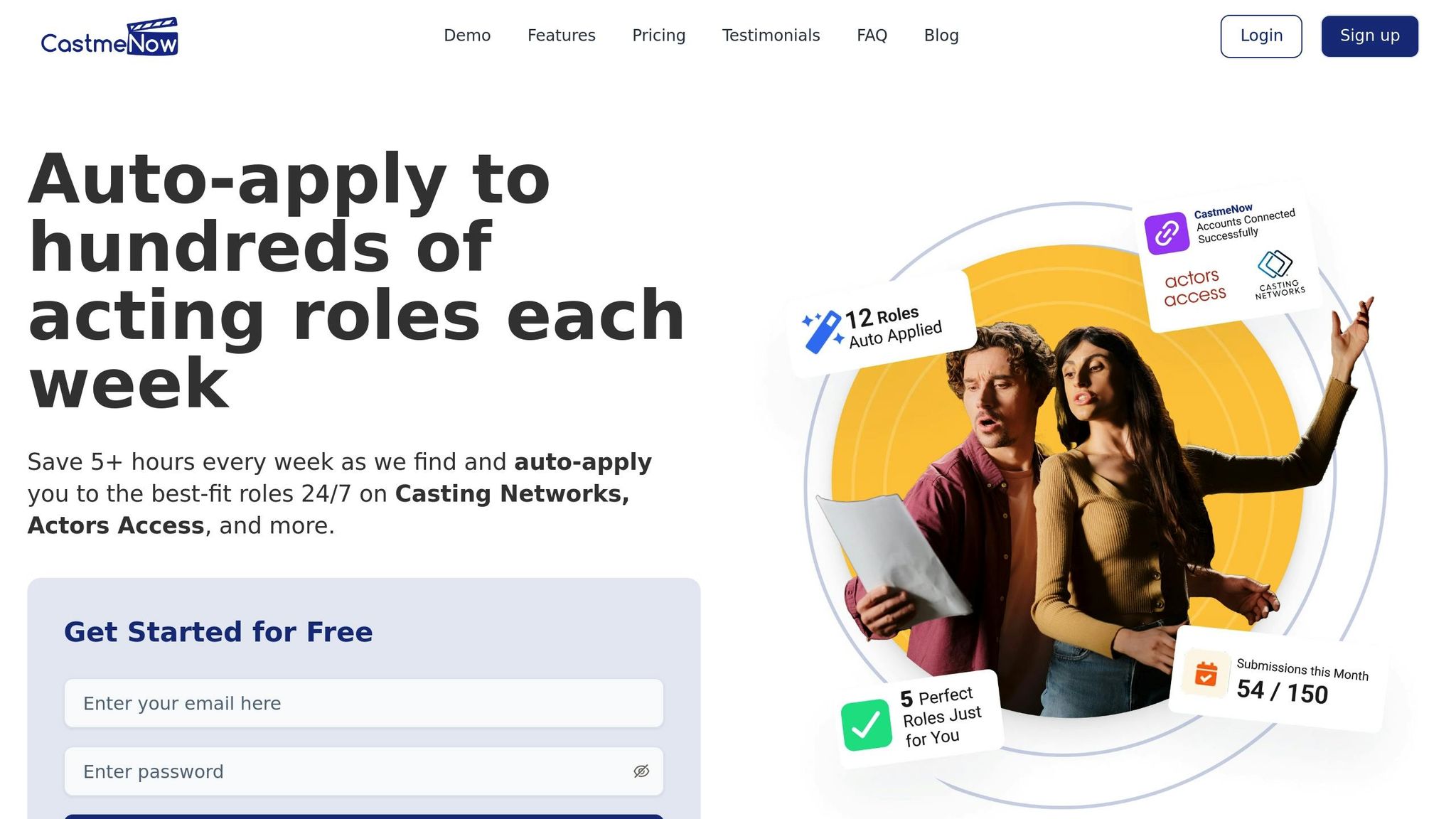How Role Matching Works in Casting Platforms
Explore how role matching technology streamlines the casting process, helping actors efficiently find roles that fit their skills and preferences.

Role matching technology has revolutionized how actors find roles, making the casting process faster and more efficient. Here's how it works and what you need to know:
- What It Does: Casting platforms use your profile (headshots, skills, experience) to match you with roles based on specific requirements.
- Key Benefits: Saves time, ensures you don’t miss opportunities, and helps you focus on auditions and skill-building.
- How It Works:
- Your profile is analyzed for physical traits, skills, and preferences.
- Casting notices are filtered by criteria like age, experience, and location.
- Matches are scored for compatibility, and you can apply manually or use auto-apply tools like CastmeNow.
- Automation Tools: Features like Smart Auto-Apply ensure you’re always in the running for new roles.
To succeed, keep your profile updated, define your preferences clearly, and monitor your progress to improve match accuracy. These tools help actors save hours each week while staying competitive.
Role Matching Systems Explained
Actor Profile Components
Casting platforms evaluate several key elements from an actor's profile - like headshots, resumes, physical traits, and special skills - through a Unified Profile Hub. This hub connects seamlessly with platforms such as Casting Networks and Actors Access.
Here’s what these platforms typically analyze:
- Physical attributes: Height, weight, age range, ethnicity
- Professional details: Union membership, experience, training
- Performance capabilities: Acting styles, accents, unique skills
- Technical requirements: Updated headshots, size cards, media reels
Role Requirements
Once actor profiles are in place, casting platforms match them to specific role requirements. Casting directors define detailed criteria, which these systems use to filter candidates. These requirements often include both essential and preferred qualifications:
| Requirement Category | Common Specifications |
|---|---|
| Physical Traits | Age range, height, build |
| Professional Status | Union membership, experience |
| Technical Skills | Language proficiency, special abilities |
| Production Details | Shooting dates, location needs |
Matching Logic
The matching process involves analyzing various data points to link actors with roles that suit them best. Here's how it works:
- Profile Analysis: The actor's digital profile is thoroughly evaluated.
- Requirement Mapping: Role specifications are broken into measurable criteria.
- Compatibility Scoring: A compatibility score is calculated based on how well an actor's profile aligns with the role.
Advanced systems also factor in actors' preferences, making matches more precise. For instance, CastmeNow’s Smart Auto-Apply feature evaluates preferences like union status and media assets to automatically submit applications for fitting roles.
Actors who keep their profiles updated and clearly outline their preferences are more likely to receive relevant matches. This increases their chances of landing roles while making the casting process faster and more efficient. By understanding how these systems work, actors can better optimize their profiles and leverage automated tools for improved results.
Susan Fox: How Casting Directors Find You
Step-by-Step Role Matching
This section provides a clear, actionable approach to matching roles, building on the earlier discussion of matching logic.
Basic Filters
Role matching begins with essential screening criteria. These filters narrow down the candidate pool to those who meet the fundamental requirements for the role:
- Geographic proximity: Ensures candidates are located near the shooting site.
- Age and physical attributes: Matches visible characteristics specified in the role.
- Union requirements: Confirms if candidates meet union membership criteria.
Once these basic filters are applied, the process moves to a more detailed evaluation.
Detailed Matching
After passing the initial filters, platforms use secondary criteria to identify actors who are best suited for the role. This step relies on data from the actor's updated profile and the specific role requirements.
| Matching Criteria | Details |
|---|---|
| Performance Skills | Includes acting styles, dialects, languages |
| Technical Assets | Headshots, demo reels, size cards |
| Special Abilities | Stunts, musical talents, combat skills |
| Experience Level | Past roles, training, workshops |
Submitting Applications
Casting platforms typically offer two ways to submit applications:
Manual Submission
- Review matched roles one by one.
- Select specific materials to include.
- Customize application details as needed.
Automated Submission
Automated tools, like CastmeNow's auto-apply feature, simplify the process by managing repetitive application tasks. These options allow actors to efficiently act on the tailored matches identified.
To make the most of these systems, actors should:
- Keep profiles updated with accurate and complete information.
- Clearly define role preferences.
- Regularly review submission settings.
- Pay attention to feedback for continuous improvement.
An optimized profile, as discussed in later sections, plays a key role in improving submission accuracy and match success.
Automated Role Matching
Why Use Automation
Automating the role-matching process takes the hassle out of searching and applying for roles manually. It can save actors over 5 hours each week, giving them more time to focus on what really matters:
- Preparing for auditions
- Sharpening their skills through training
- Handling other career priorities
- Quickly responding to callback requests
These time-saving benefits are made possible through the features offered by CastmeNow.
CastmeNow Features

CastmeNow uses an intelligent matching algorithm to connect actors with roles that match their preferences and attributes.
| Feature | What It Does |
|---|---|
| Smart Auto-Apply | Automatically applies to roles within 2 hours of posting |
| Unified Profile Hub | Links all your casting platform accounts in one place |
| Preference Settings | Matches you with roles aligned to your career goals |
| 24/7 Operation | Ensures you never miss an opportunity |
These tools help actors maintain a steady flow of submissions while dedicating their energy to improving their craft and preparing for auditions.
Performance Tracking
Keeping your profile optimized goes hand-in-hand with tracking your performance. Monitoring these key metrics ensures every automated submission works to your advantage:
- Number and types of roles applied for
- Callback rates and response trends
- Indicators of how well your profile is performing
"The platform has been working great over the past few weeks, and I've actually started getting callbacks now!" - Haeleigh
"I just started acting last June. I don't even have professional headshots but with CastmeNow, I started getting background roles within a week." - Daniel, Actor
Profile Optimization Guide
Regular Profile Updates
Keeping your profile up-to-date is key for accurate role matching. Here's how often to update essential elements:
| Element | Update Frequency | Key Details |
|---|---|---|
| Headshots | Every 6–12 months | Reflect your current look with varied expressions. |
| Resume | Monthly | Include recent credits, training, and achievements. |
| Demo Reels | Quarterly | Showcase recent work and a range of scenes. |
| Size Cards | As needed | Ensure measurements and photos are accurate. |
If you're using platforms like CastmeNow, make sure your profiles are synchronized across all platforms for consistent automated submissions. Also, set clear preferences to improve match accuracy.
Setting Clear Preferences
Defining your preferences ensures better role matches. Be specific about:
- The types of roles and categories you're interested in.
- Your union status and affiliations.
- Your availability for projects.
Don't forget to emphasize any standout skills that align with what the industry is looking for.
Highlighting Special Skills
Standout skills can set you apart in automated matching systems. Here's how to showcase them effectively:
-
Skill Categories: Organize your skills under categories such as:
- Performance: Accents, improvisation, stage combat.
- Physical Abilities: Dance styles, sports, martial arts.
- Technical Skills: Playing instruments, speaking languages.
-
Experience Details: Provide specifics like:
- Years of training or practice.
- Notable performances or demonstrations.
- Relevant certifications or qualifications.
-
Unique Attributes: Highlight what makes you different, such as:
- Rare talents or abilities.
- Specialized training or expertise.
- Knowledge of specific cultures or languages.
These details can make your profile stand out in a competitive field.
Next Steps
It's time to take action and make the most of your opportunities.
Set Up Automated Applications
Link your casting profiles to automation platforms to save time and increase efficiency. The Basic Plan costs $5/month and allows 5 daily auto-applies, while the Unlimited Plan, at $12/month, lets you submit without limits. Before setting up automation, double-check that your profile details are accurate and up to date.
Keep Your Profile Accurate
The success of your role matching largely depends on the accuracy of your profile. Even a basic profile can deliver results if it's configured correctly. Automation can handle repetitive tasks, but staying actively involved in managing your career is just as important.
Combine Automation with Active Management
Don't rely solely on automation. While it helps maintain consistent submissions, actively managing your career ensures you can focus on honing your skills and seizing new opportunities.
Monitor Your Progress
Keep an eye on how your submissions are performing. Look for patterns in the roles that lead to callbacks and adjust your preferences accordingly to improve your chances.
"The site is working great! I've actually been overwhelmed with auditions from it." - Olivia
FAQs
How can actors optimize their profiles to get matched with the right roles on casting platforms?
To improve your chances of being matched with the right roles, make sure your profile is complete and up-to-date. Highlight your skills, experience, and unique attributes that make you stand out. Specify your preferences, such as role types, locations, and availability, so the platform can better align opportunities with your goals.
By keeping your profile accurate and tailored to your strengths, you'll increase your visibility and ensure casting platforms can connect you with roles that truly fit your talents.
How can automated tools like Smart Auto-Apply benefit actors during the casting process?
Automated tools like Smart Auto-Apply offer actors a streamlined way to handle the casting process. By automating applications on platforms such as Casting Networks and Actors Access, these tools can save actors hours of time each week.
This time-saving feature allows actors to focus more on honing their craft, attending auditions, and managing other aspects of their careers. With automation working 24/7, actors can ensure they never miss out on opportunities that align with their preferences.
How do casting platforms match actors with the right roles?
Casting platforms use advanced systems to match actors with roles based on their profiles and preferences. Key factors like age, location, skills, appearance, and experience are often considered to ensure compatibility with specific roles.
Platforms like CastmeNow enhance this process by automating role applications. By connecting to casting profiles such as Casting Networks and Actors Access, it continuously scans for opportunities that align with your preferences and auto-applies on your behalf, saving you time and effort. This streamlined approach ensures actors never miss out on relevant opportunities.

